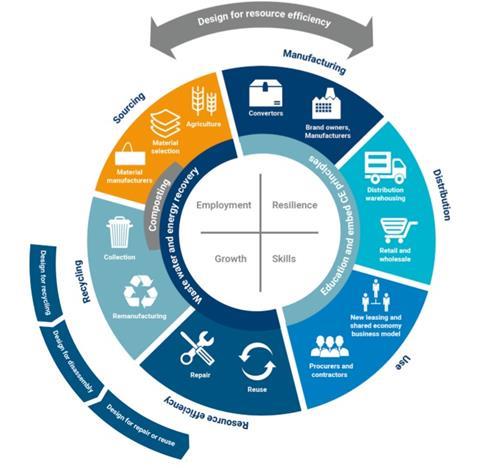With an increase in global production and consumption of plastics, and less than 20 percent of plastics recycled globally, plastic waste is increasing – and mismanaged.
The impacts of plastic production, use and disposal on the environment and people create risks and opportunities for investors through different sectors and companies which are part of the plastic value chain. This report highlights the global challenge for plastics, as well as some potential solutions.
Key findings:
- Global production and consumption of plastic has increased by over a factor of 20 since the 1960s. Today, 40 percent of global plastics production is for packaging and 95 percent is single-use.
- Although demand for plastic is forecast to continue rising, growth in production and consumption is coupled with an inefficient global waste management system, resulting in less than a fifth of plastic waste being recycled. As plastic does not break down naturally, it is polluting natural systems, including rivers and oceans.
- The production, use and disposal of plastics also creates significant greenhouse gas emissions throughout the different stages of the plastic value chain. According to research by the Center for International Environmental Law, greenhouse gas emissions from plastic could represent 10-13 percent of the entire remaining carbon budget by 2050 (in the context of the 1.5 degree goal of the United Nations Framework Convention on Climate Change Paris Agreement).
- As the environmental consequences of plastic become increasingly apparent, regulation and consumer behaviours have started to change. The impact of plastic pollution on the marine environment in particular has been in the spotlight, posing reputational risks for companies and investors.

Source: Adapted from Anthesis
- As regulations shift countries toward circular economy models, there are opportunities for future investments to address plastic pollution and the other related impacts. Potential solutions exist at each stage of the circular economy: design, reuse, repair and recycling.
- However, solutions cannot be assessed in isolation and must be considered in the context of the whole plastics value chain. Collaboration across the value chain is required in order to develop impactful solutions. Investors can encourage collaboration and consider the rest of the value chain when investing in solutions.
References
- Ryberg, M. W., Laurent, A. and Hauschild, M., 2018. Mapping of global plastics value chain and plastics losses to the environment. [pdf] Nairobi: United Nations Environment Programme.
- Jambeck, J.R., Geyer, R., Wilcox, C., Siegler, T.R., Perryman, M., Andrady, A., Narayan, R. and Law, K.L., 2015. Plastic waste inputs from land into the ocean. Science, 347(6223), pp.768-771.
- World Bank, 2019. What a Waste Global Database.
- Geyer, R., Jambeck, J.R. and Law, K.L., 2017. Production, use, and fate of all plastics ever made. Science advances, 3(7), p.e1700782.
- Eurostat, 2019. Recycling rates for packaging waste.
- Ministry of Environment, Japan, 2018. Japan’s Resource Circulation Policy for Plastics.
- United States Environmental Protection Agency, 2019. Plastics: Material Specific Data.
- Iniciativa Regional para Reciclaje Inclusivo, 2018. Estudio comparativo de legislación y políticas públicas de Responsabilidad Extendida del Productor – REP para empaques y envases.
- Reloop, 2017. Reloop Releases Global Overview of Deposit Return Systems.
- Geyer, R., Jambeck, J.R. and Law, K.L., 2017. Production, use, and fate of all plastics ever made. Science advances, 3(7), p.e1700782.
- Plastics Europe, 2018. Plastics – the Facts 2018.
About The plastics landscape series
This is the first report in a series aimed at equipping investors with the information they need to understand plastic as a systemic issue, providing a technical overview of plastic and the plastic market, and exploring common concepts.
The series will help investors to identify where and how their portfolios might be exposed to plastic, enabling them to analyse relevant sectors and engage at the corporate and policy levels accordingly.
The second report looks at risks and opportunities along the plastics value chain, and the third covers the regulations, policies and other influencers of change in how plastic is managed.
Find out more about our work on plastics and the circular economy.
Downloads
PRI Plastics Landscape Challenges and Possible Solutions
PDF, Size 1.19 mb












